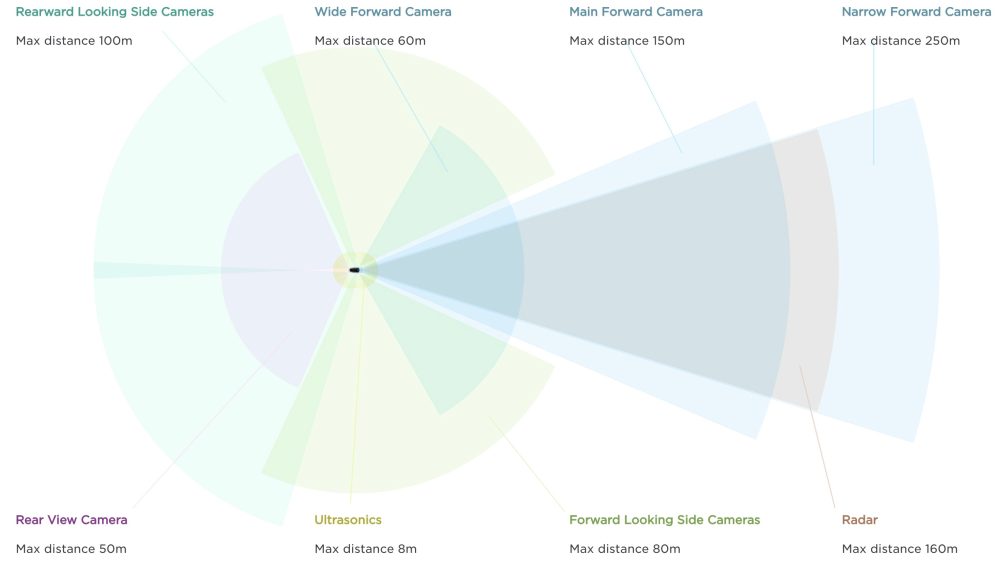We learn that Tesla is looking to add a new “4D” radar with twice the range of its current radar in order to help its self-driving effort.
Tesla Loves cameras and radar, hates lidar
Early on its Autopilot and self-driving effort, Tesla made a clear decision to bet on computer vision powered by camera and complemented with radar.
CEO Elon Musk famously hates the use of lidar sensors for autonomous driving systems.
Yesterday, he even told an analyst that Tesla wouldn’t use lidar sensors. Early ones were known to be expensive but have come down in price in recent years, even if they were free:
I mean totally free, well, I think even if it was free, we wouldn’t put it on.
Instead, Tesla is using eight surround cameras around its vehicles complemented by 12 ultrasonic sensors and a front-facing radar.

All Tesla vehicles since 2016 have been equipped with this suit of sensors or at least similar versions of it, as some hardware updates have been introduced over the years.
But the sensors might be getting their biggest update since the introduction of Autopilot 2.0.
Tesla updating its radar
For the radar, Tesla has been Continental’s ARS410 automotive radar with a range of 160 meters (525 ft), according to the automaker.
Now we learn that Tesla is looking to update the radar with a new 4D sensor technology from an Israeli startup called Arbe Robotics.
We have two different indications that Tesla is preparing to move to the new radar technology.
Firstly, the Tesla software hacker known as “green,” who has reliably been finding hints of new features by sleuthing in Tesla’s software updates, alerted us that the automaker added a new radar option called ‘Phoenix” in a recent software update:
Phoenix is the name of Arbe’s radar system. From the company’s website:
Phoenix, Arbe’s radar chipset solution, services real-world driving needs by identifying, assessing, and responding to challenging scenarios from the common to the exceptional with 4D ultra-high resolution real-time imaging. No matter the speed, elevation, proximity, size, or surrounding weather and lighting conditions, Phoenix differentiates true threats from false alarms to ensure a safe road ahead for drivers, pedestrians, and other vulnerable road users.
Electrek has contacted Arbe for a comment, but the company is not answering inquiries.
Secondly, a source told Electrek that Tesla is preparing to update the Model 3 fascia and new sensors would be part of that update.
Of note, we recently reported on a new Tesla prototype spotted in rare camouflage with a possibly updated fascia in Los Angeles earlier this week.
The Arbe Phoenix 4D radar
The company describes its technology as a breakthrough for radar:
Arbe’s proprietary baseband processing chip integrates radar processing unit (RPU) architecture with embedded radar signal processing algorithms to convert massive amounts of raw data in real-time while maintaining low silicon power consumption. Arbe’s patent pending processing chip manages up to 48 Rx channels in combination with 48 Tx channels in real-time, generating 30 frames per second of full 4D image, with equivalent processing throughput of 3 Tb/sec.
According to the specs, it would almost double the range of Tesla’s current radar to 300 meters (984 feet).

They describe their technology as enabling the production of a full 4D image, which is something Tesla CEO Elon Musk has been talking about doing with Tesla’s Autopilot rewrite.
Musk recently said:
We are moving from things like isolated pictures and doing image recognition on pictures that are harshly correlated in time but not very well and transitioning to a kind of 4D, where it’s like video essentially. You’re thinking about the world in three dimensions and the fourth dimension being time. So that architectural change, which has been under way for some time but has not really been rolled out to anyone in the production fleet, is what really matters for Full Self-Driving.
Arbe’s radar could help Tesla to add the “time” dimension to its recognition system.
The company says that its system enables “distance, height, depth, and speed to simultaneously be assessed in high resolution.”
Electrek’s Take
Now the big question is what the rollout is going to look like, and does Tesla actually need the new radar technology to deliver a full self-driving system?
My guess is that it will certainly help, but Tesla has been adamant that they can deliver FSD on the current hardware.
Now the next question is that even if it’s not essential and it’s just Tesla improving their system with the latest technology, are they going to allow retrofits?
Based on Tesla’s history, I think that’s not really likely.
Tesla hasn’t been very open to that other than for its FSD computer, but it really had to do that to deliver the promised capabilities.
We will keep a close eye on the rollout and keep you updated as we learn more.
FTC: We use income earning auto affiliate links. More.
Subscribe to Electrek on YouTube for exclusive videos and subscribe to the podcast.